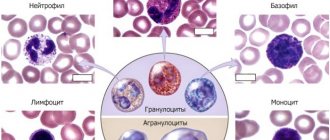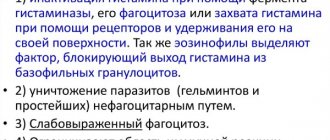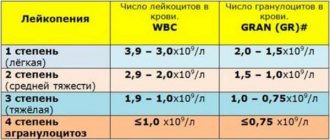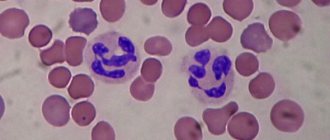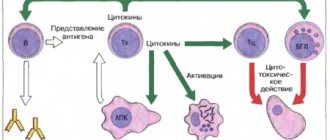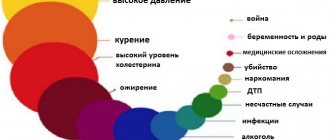Types and functions of blood cells
Granulocytes are white blood cells, a type of leukocyte. Under a microscope, it can be seen that the structure of these cells is similar to grains or granules - hence the name.
The main center for the production of all types of leukocytes is the bone marrow, and their main purpose is to protect the body from external and internal pathogens.
Although white blood cells are considered blood cells, they are able to leave the bloodstream by penetrating through capillary walls into the spaces between other cellular particles in the body.
Being in the intercellular space, leukocytes actively suppress the activity of foreign elements.
Some types of white cells have the ability to absorb foreign bodies - this process is called phagocytosis in medicine.
In confrontation with foreign elements, white blood cells die, but new ones immediately rush to their place, produced by the bone marrow and stored there until a certain moment, as in a warehouse.
There are two types of white blood cells - the granular type, known as granulocytes, and the non-granular type, known as agranulocytes.
The bloodstream of a healthy person contains a certain amount of each type of cell; any deviations from the norm are considered as a sign of unhealthy processes and require medical intervention.
In relation to other types of leukocytes, granulocytes are the most numerous and make up up to 80 percent. In the results of a blood test, the quantitative composition of white cells is indicated in the leukocyte formula.
There are three types of granulocytic type cells:
Neutrophil granulocytes are segmented or band cells, the main type of leukocytes in human blood.
Neutrophils are called segmented because their nucleus is divided into several segments.
The task of these cells is to perform an antimicrobial function in the body, neutralizing bacteria and fungi through phagocytosis (absorption).
Immature forms of cells are called rod cells; they are practically absent in the blood of a healthy person.
Exceptions include expectant mothers and newborn children, for whom the presence of immature neutrophils in the blood is considered normal.
In newborns, high levels of band granulocytes can persist for up to a year.
An increase in the number of immature cells indicates depletion of cell mass reserves, which occurs during intense inflammatory processes. A low level of neutrophil granulocytes is called neutropenia.
Eosinophils are granulocytes with a bilobed nucleus. Moving towards the affected inflamed tissues, eosinophil cells actively participate in antiparasitic immunity, ensuring the maintenance of immediate allergic reactions and absorbing foreign particles. Low levels of eosinophils are called eosinophilia.
Basophils are a subtype of granulocytes with large nuclei. The mission of these cells is to maintain immediate allergic reactions and participate in blood clotting processes. A decrease in the level of basophils in the blood is called basopenia.
Granulocytes or GRA in a blood test are low in an adult - what does this mean?
Granulocytes are reduced - what does this mean? Probably, most people know that any deviation in the composition of the blood indicates a malfunction in the body, and there is also an incomprehensible name - granulocyte. But before considering the danger of a decrease in the granulocyte level, probably as when analyzing other blood parameters, it is worth considering what this component is and why the body needs it.
What is this component
This is a type of leukocyte, which contains granular nuclei. Depending on the purpose of these white blood cells, there can be from 2 to 5 nuclei, and it is they who play the leading role in ensuring cellular immunity.
In a healthy person, myeloblasts (precursor cells) mature in the bone growth, from which granulocytic cells then arise.
These blood components differ in the following characteristics:
- Short life expectancy. These cells, depending on the type, live 2-10 days and do not have genetic memory, like, for example, some other types of leukocytes.
- Unpretentiousness. At the site of inflammation, the tissues are almost always swollen and insufficiently supplied with oxygen, but for granulocytes that are able to metabolize glucose to provide cellular nutrition anaerobically, low oxygen levels are not an obstacle to their full functioning.
These features do not allow granulocyte cells to recognize viruses that have entered the body and prevent the development of the inflammatory process, but they are actively involved in suppressing the inflammatory process and help eliminate waste products of pathogenic microbes.
Causes of granulocytopenia
When studying the test results, the doctor takes into account not only the degree of decrease in granulocytes, but also which elements have decreased:
- Neutrophils. They are reduced in leukemia and other oncological diseases, anemia, chronic intoxication or long-term inflammation. A decrease in the neutrophil index during acute inflammatory processes occurs very rarely.
- Eosinophils. They are abundantly destroyed during acute poisoning and toxic shocks, with extensive injuries or burns, severe physical fatigue, or with acute rapid development of infection. A decrease in the number of eosinophils always indicates acute processes.
- Basophils. Alone among all granulocytic elements, they create an antigen-antibody complex and slowly destroy the foreign body. They are involved in large quantities in the development of a response to a stimulus (penetration of an allergen into the body, a stress factor, or the use of certain hormonal drugs). Reduced basophils are also observed in pregnant women and in women after ovulation. But in the last 2 cases, the decrease is considered normal and is not a sign of the disease.
The granulocyte formula alone cannot indicate deviations from the norm that have arisen in the body. Only a doctor can determine what developed granulocytopenia means.
How to get the most reliable analysis
A blood test for granulocytes requires almost no preparation from the patient, and is taken from the patient on an empty stomach, from a finger prick.
But still, in order to avoid diagnosing false granulocytopenia, doctors recommend 2-3 days before the test:
- do not eat food with large amounts of preservatives (smoked foods, canned food, chips, etc.);
- give up alcohol (alcohol tinctures, for example, valerian or motherwort, are acceptable in small quantities);
- do not take medications, especially those containing hormones (if this is not possible, for example, with hyperthyroidism or diabetes, then you must inform your doctor about the medications you are taking);
- avoid physical fatigue (persons engaged in heavy physical labor are advised to take a day off from work, and athletes are advised to skip the next training session);
- do not be nervous, because the stress factor has a destructive effect on basophils.
In the morning before donating blood, do not eat or drink anything, and also stop smoking. Following these simple rules will help you get more reliable results.
What does a decrease in granulocytes mean? It indicates that not everything is fine in the body and leukocyte cells are destroyed under the influence of unfavorable factors. But what pathological processes are occurring cannot be determined only with the help of analysis, but characteristic changes in granulocyte parameters will prompt the doctor to further examine the plan for a more accurate diagnosis of the disease.
Source: https://BolezniKrovi.com/analizy/obshhij/granulotsity-ponizheny.html
Reasons for the decrease in eosinophilic and basophilic granulocytes
When the results of a blood test show a decrease in granulocytes, it is difficult to understand what this means without medical education. You need to know what analysis indicators are considered normal.
Quantitative norms of granulocyte cells in the blood are designated using the abbreviation GRA and are indicated either as a percentage of the total number of leukocytes (GRA%) or as an absolute indicator (GRA #).
Accordingly, when deciphering the results of the analysis, doctors are guided by this normal indicator - 1.2 - 6.8 * 10⁹ per liter of blood or 47 - 72 GRA% of the total level of leukocytes.
The results of the analysis indicate the number of immature granulocytes. The normal level of indicators of such cells can range from 1 to 5 percent.
If the analysis shows that immature granulocytes are low, then this is regarded as a sign of problems with the functionality of the immune system.
For each type of granulocytes, there are normal indicators established by medicine.
Basophils and eosinophils
Basophils are small cells that fight inflammatory processes of allergic origin. They are directly involved in the process of anaphylactic type and indirectly in delayed type reactions when communicating with lymphocytes.
The cells help release substances necessary for the body such as histamine, serotonin, and heparin.
The following phenomena can reduce the level of these substances in a child’s body:
- stress;
- pneumonia;
- acute infections;
- side effects of medications.
If there is a reduced level of these cells in the blood, then this condition requires immediate examination, which will help determine the exact cause of the decrease in basophils in the body.
Eosinophils interact with basophils, which help form antigens.
A reduced content of these cells in the blood can be observed in the presence of the following pathologies:
- side effect from taking medications;
- bacterial infections;
- overwork;
- stress;
- recovery period after surgery;
- burns;
- sepsis;
- injuries;
- anemia.
Low levels of these cells in children cause major health problems. Such children suffer from problems with the process of hematopoiesis. This condition requires constant monitoring by doctors, as well as treatment.
Reasons for the decrease in neutrophil granulocytes
Typically, granulocyte levels change throughout a person's life. Indicators in an adult differ from the level of white cells in children under one year old.
If the granulocyte counts are lower than normal, then the doctor’s task is to determine the cause of the pathology and eliminate it by prescribing a course of treatment.
Neutrophil granulocytes mature in the bone marrow. This period takes an average of 10 days, and then the cells enter the bloodstream and perform their protective functions for 10 hours. The highest concentration of neutrophils is observed in the affected tissues.
A decrease in the level of neutrophil cells (neutropenia) can be a symptom of the following human pathological conditions:
- radiation injury;
- neoplasms in the bone marrow - leukemia, myelofibrosis;
- various types of anemia;
- typhoid fever;
- diabetes mellitus;
- toxic goiter;
- malaria;
- bacterial infections - brucellosis, tularemia;
- viral infections - influenza, rubella, various subtypes of hepatitis, AIDS;
- autoimmune pathological conditions - collagenosis, lupus erythematosus;
- depletion of the biological potential of the body against the background of chronic alcoholism, cachexia;
- hypersplenism;
- taking medications with toxic effects - tranquilizers, antibiotics, immunosuppressants;
Neutrophils may be low in a child with congenital Kostman syndrome. As a result of the development of this pathology, the bone marrow loses the ability to produce the required number of neutrophils.
The consequences of the disease are more than serious - a general weakening of cellular immunity is accompanied by multiple inflammatory lesions of the skin and internal organs, which often leads to death.
The degree of development of neutropenia is reflected in the results of a blood test as follows:
- mild form - the number of neutrophils is from 1*10⁶/ml;
- severe form - the number of neutrophils is less than 5*10⁵/ml.
To make an accurate diagnosis, it is very important to know the degree of relationship between mature and immature forms of granulocytes. Autoimmune diseases and congenital forms of leukopenia can reduce the levels of immature white cells.
A decrease in granulocytes against the background of an increase in the number of leukocytes is always a symptom of intense inflammatory processes.
In addition, granulocyte counts often change during the summer. Summer is the time of activity of allergens, bacteria and fungi, the damage to which is reflected in a blood test.
In children under one year old, the rate of immature granulocytes cannot exceed 4%, from one year to 6 years - 5%, upon reaching 15 years - no more than 1 - 5%.
Granulocytes are reduced: what does this mean, reasons – Diagnostics
Granulocytes are leukocytes, in the protoplasm of which granules resembling grains are visible. They are formed by the bone marrow from the granulocytic hematopoietic shoot. A situation where granulocytes are low in a blood test occurs quite often and requires medical intervention.
Immature granulocytes are reduced - what does this mean?
The materials are published for informational purposes only and are not a prescription for treatment! We recommend that you consult a hematologist at your medical institution!
Co-authors: Natalya Viktorovna Markovets, hematologist
Granulocytes are a type of white blood cell. These cells can be present in human blood in three stages: immature (or young), not fully mature and mature.
Since these blood cells reach full maturity within three days, they remain in an immature state for a minimum period of time. Therefore, their amount in the blood is normally minimal.
Pathology is most often spoken of when the number of granulocytes is increased, however, their too small presence in the blood also indicates the development of diseases.
What types of granulocytes are there: neutrophils, eosinophils and basophils
Granulocytes are one of the subtypes of leukocytes. These cells got their name due to their granular structure, which resembles granules. They are produced by the bone marrow.
These cells provide protection to our body from germs and infections. They are able to be the first to recognize that something is wrong and move to the source of the lesion. Thus, if their number is increased, this indicates the development of inflammation. They also correct the immune system.
Types of granulocytes
Granulocytes are of the following types:
- Neutrophils. They belong to one of the most numerous groups, accounting for up to 80% of the total number of leukocytes. The main task of neutrophils is phagocytosis, or the search and destruction of harmful bacteria and viruses.
- Basophils. Small cells with large nuclei and a small amount of cytoplasm. They fight inflammation and participate in anaphylactic processes.
- Eosinophils. Make up less than 5 percent of the number of leukocytes. These cells are responsible for phagocytosis.
Read also on the topic Eosinophil Norm in Children in addition to the current article.
What does a low granulocyte count indicate?
Low granulocyte content in the blood
As mentioned above, the relative content of granulocytes in the blood is very small. However, there are situations in which immature granulocytes are reduced. What does it mean? This may indicate the development of serious diseases in the body.
For example, with a decrease in neutrophil granulocytes, the following diseases may be diagnosed in a patient:
- malaria;
- lupus erythematosus;
- tularemia;
- rubella, influenza;
- hepatitis;
- AIDS;
- radiation sickness;
- enlarged spleen.
Important! In a breastfed child, a decrease in neutrophil levels may occur due to congenital neutropenia. This disease can lead to disastrous consequences, including death. It manifests itself in the form of chronic infectious diseases or on the skin.
Also, a decrease in neutrophil granulocytes can occur due to alcoholism.
Large physical overloads can lead to a decrease in the number of granulocytes
The reasons for the decrease in the number of eosinophils may be as follows:
- physical stress;
- previous surgical interventions;
- anemia;
- polytrauma;
- extensive burns;
- prolonged exposure to stress;
- acute bacterial infections, etc.
We also recommend that you pay attention to the article: “Reduced eosinophils in the blood of an adult.”
If granulocytes are low in a very young child, this indicates that the immune and hematopoietic systems are not fully formed. Everything will return to normal in time. With a decrease in the number of basophils, basopenia develops, which occurs against the background of such diseases:
- pneumonia;
- acute infections;
- Cushing's syndrome;
- stress;
- diseases of the thyroid gland.
Important! A decrease in the level of basophils can also occur when taking hormonal drugs or due to any hormonal imbalances in the body.
A decrease in granulocytes can occur against the background of constant stress
A decrease in the level of granulocytes in an adult and a child can be caused by serious pathologies of the body, and therefore in this case a comprehensive examination is required to identify the cause and treat the disease that has led to a deviation in the level of blood cells.
We recommend studying similar materials:
- 1. Reasons for an increase or decrease in neutrophils in a blood test in children?
- 2. What does a high level of neutrophils mean and is it dangerous?
- 3. What do elevated eosinophils mean in a blood test in adults?
- 4.
What to do if there is an increased level of bilirubin during pregnancy? - 5. What to do if the level of basophils increases and what does this mean?
- 6. Low level of total bilirubin in the blood: reasons for the decrease
- 7.
Lymphocytes during pregnancy: increase and decrease in indicators
Source:
Granulocytes are low, what does this mean?
Granulocytes
– leukocytes, which inside contain granularity, consisting of small parts filled with active components. They appear in the bone marrow from the corresponding germ.
Presented as three main types: basophils, neutrophils and eosinophils. To determine the indicators, appropriate tests are performed. If granulocytes are low, this may mean that a virus is spreading in the body, or there are blood pathologies.
In any case, all this requires the appointment of special therapy.
Granulocytes in the blood are low - what does this mean?
Typically, such test results indicate autoimmune diseases. Often the cause can be safely considered to be a decrease in the number of eosinophils, which reduces the effectiveness of the immune system. This usually occurs in certain diseases:
- Sometimes reduced results may be associated with taking certain medications - antibiotics, sulfonamides and antitumor drugs.
- Immature granulocytes are reduced - what does this mean?
- Low amounts of these components in the blood usually indicate:
Source: https://zdoroviecrimea.ru/kt/granulotsity-ponizheny-chto-eto-znachit-prichiny.html
Features of granulocytes
Granulocytes, or granular leukocytes, are a type of white blood cells that are characterized by the presence of granules containing active substances in the cytoplasm. Depending on the ability of granules to perceive staining with the combined Romanovsky-Giemsa reagent, granulocytes are divided into:
- Basophils (absorb the alkaline component of the complex dye)
- Eosinophils (stained with the acidic component eosin)
- Neutrophils (equally perceive both components)
Determination of the absolute and relative amount of the granulocyte fraction (GRA) is one of the most important indicators that are assessed in the study of a general blood test. Timely detected and correctly interpreted quantitative GRA deviations play an important role in modern diagnostics.
Life cycle and functions of granulocytes
All types of granular leukocytes originate from a single stem cell in the red bone marrow. Here, over several stages, the process of their differentiation into neutrophils, basophils and eosinophils occurs. Depending on the degree of maturity, cells are distinguished:
- Young
- Immature (rod)
- Mature (segmented)
The entire cycle of granulocyte maturation takes place in the red bone marrow, after which the formed cells enter the bloodstream. A slight presence of immature forms of granular leukocytes in the blood is also considered a normal variant.
Once in the bloodstream, granulocytes are divided into two populations: freely circulating and mural. Parietal standing is an intermediate phase of the life of these cells before entering the tissues, where they move freely and perform their main functions - protective. With the development of inflammatory processes and the detection of external invasion under the influence of bioactive mediators, the parietal population increases, and leukocytes begin to actively migrate to the lesion.
All types of granular leukocytes have the ability to move and phagocytose to one degree or another, but each type has its own special functions:
- Neutrophils are microphages capable of destroying relatively small foreign particles. Contains enzymes that have an antibacterial effect.
- Eosinophils can both trigger and suppress allergic reactions in lesions and participate in the production of cytotoxic substances (cellular poisons), mainly with antiparasitic effects.
- The contents of basophil granules ensure the development of local reactions that contribute to the migration of other granular leukocytes to the site of inflammation
After the cells exit into the tissue, the countdown of the granulocyte life cycle begins. Depending on the type of cell and accompanying conditions, their lifespan ranges from 2 to 10 days.
Immature granulocytes are reduced - what does this mean?
The materials are published for informational purposes only and are not a prescription for treatment! We recommend that you consult a hematologist at your medical institution!
Co-authors: Natalya Viktorovna Markovets, hematologist
Granulocytes are a type of white blood cell. These cells can be present in human blood in three stages: immature (or young), not fully mature and mature.
Since these blood cells reach full maturity within three days, they remain in an immature state for a minimum period of time. Therefore, their amount in the blood is normally minimal.
Pathology is most often spoken of when the number of granulocytes is increased, however, their too small presence in the blood also indicates the development of diseases.
What types of granulocytes are there: neutrophils, eosinophils and basophils
Granulocytes are one of the subtypes of leukocytes. These cells got their name due to their granular structure, which resembles granules. They are produced by the bone marrow.
These cells provide protection to our body from germs and infections. They are able to be the first to recognize that something is wrong and move to the source of the lesion. Thus, if their number is increased, this indicates the development of inflammation. They also correct the immune system.
Normal granulocyte content in the blood
Diagnostically significant are not only the absolute and relative indicators of the number of all types of granulocytes in the blood, but also the ratio of their immature and mature forms. For adults, the following indicators are considered normal:
- Neutrophils: band - 0.1-0.35*10 9 /l (2-6% of the total number of leukocytes)
- segmented - 2-6*10 9 /l (47-70%)
In practice, the content of immature forms of neutrophils in a sample is considered clinically significant. The relatively low content of eosinophils and basophils in the blood does not make it possible to accept the ratio of their immature and mature forms as statistically significant.
Clinical blood test
The absolute and relative content of immature and mature granular leukocytes is determined by a clinical blood test.
- Blood is taken for analysis from a finger; in some cases, when a detailed study is required, it is taken from a vein.
- The sample is taken in the morning, on an empty stomach. Eating leads to an increase in the content of leukocytes in the blood, so you should not have breakfast, and it is also not recommended to consume fatty heavy foods or alcoholic beverages on the day before blood sampling. In the morning you can drink water, but not carbonated water.
- If we are talking about infants, then feeding should be done at least an hour and a half before the procedure.
- If a person is taking medications and cannot take a break from taking them, the attending physician must be notified.
A clinical blood test can tell a specialist a lot. Of considerable interest in this regard is the amount of immature granulocytes contained in a blood test.
Features of the norm of granular leukocytes in children
When reading the leukocyte formula in children, two nuances must be taken into account. Firstly, before adulthood, the relative number of granulocytes varies widely depending on age: from 30 to 70%. But for making a correct diagnosis, another factor is more indicative: the ratio of immature and mature forms of granular leukocytes.
During the life of a child, the relative number of immature forms remains approximately the same and does not exceed 5-6% of the total number of leukocytes. The number of mature granulocytes in the first day of a child’s life is at the adult level (up to 70%), but by the end of the first month it decreases to an average of 12-20%. In subsequent years of life, the indicators of mature forms gradually shift towards the adult norm, and reach it by 15-16 years.
Increased granulocyte level
An increase in the level of granulocytes in the blood (granulocytosis) is due to the functions that these cells perform in the body. An increase in the number of granular leukocytes is usually a consequence of a compensation mechanism: in conditions when a large number of granulocytes die, their “production” is activated. This condition is typical for:
- acute infections
- malignant tumors
- drug and food poisoning
- parasitic lesions of the body
- allergic reactions of various types
Under these conditions, when the lesion experiences an acute shortage of granulocytes, young forms of cells enter the bloodstream, and their maturation occurs already in the bloodstream. In this case, they speak of a “shift of the leukocyte formula to the left.” The picture is typical for:
- active purulent processes: gangrene, phlegmon, abscesses
- acute bleeding
- chronic skin diseases (dermatitis, psoriasis)
- myocardial and pulmonary infarction
- gout
An increase in the level of granulocytes associated with pathological processes should be distinguished from physiological conditions. The total number of granular leukocytes, including their immature forms, can increase with:
- pregnancy
- after intense physical activity
- on the eve of menstruation
- after meals
The rules for donating blood for OAC, including diet and exclusion of physical activity on the eve of collection, make it possible to exclude physiological granulocytosis.
As a rule, pathological processes, including malignant diseases of the hematopoietic system, are accompanied by a proportional increase in the number of all types of granulocytes. However, a number of conditions are characterized by an increase in individual fractions of granular leukocytes:
- An increase in the level of neutrophils is a sign of bacterial appendicitis and pyelonephritis, accompanies tissue necrosis and anemia
- The number of basophils increases with hyperfunction of the thyroid gland, granulomatosis and at the stage of remission of infectious diseases
- An increase in the number of eosinophils is an indicator of the occurrence of allergic processes in the body, including hidden ones, for example, due to parasitic invasion
Immature granulocytes are increased or decreased: what does this mean?
Granulocytes or granular leukocytes are the body's first line of defense against microbes. These cells are the first to reach the lesion and also participate in the emergence of cellular immunity.
Granulocytes include eosinophils, basophils and neutrophils, as well as their young forms - band and juvenile. All these types of leukocytes have special granules in the cytoplasm that can be stained with both acidic and basic dyes.
Normally, humans also contain varieties of leukocytes that do not contain granules. Their function is related to the formation of antibodies; these are monocytes and lymphocytes.
Myeloblasts are stem cells and are the progenitors of granulocytes, which can be mature or immature. What are immature granulocytes? These are the cells that have not fully formed and have not acquired the necessary functions characteristic of mature cells.
The most important functions of these granulocytes are to capture and neutralize foreign cells, including the neutralization of bacterial pathogenicity factors and antigens. The bone marrow is where granulocytes are formed. All granular cells penetrate human tissue, where they subsequently perform their duties.
The granulocyte nucleus has an irregular shape with division in the form of lobules, the number of which ranges from two to five; therefore, these cells can also be called polymorphonedular, that is, consisting of many nuclei.
Thus, granulocytes may include cells such as eosinophils, basophils, neutrophils, constituting up to 70% of the total number of leukocytes that are found in human blood. Each type of granulocyte is responsible for a certain type of inflammation in the body, in which they play a leading role in the fight.
However, they work together with all representatives of the series, for example, macrophages and neutrophils often react, as well as basophils and eosinophils, due to certain similarities between them.
Immature granulocytes cannot be seen in the blood of a healthy person, since they do not extend beyond the bone marrow - only mature forms circulate in the blood. However, during an emergency, there is a shortage of fighting cells. In this situation, it is young or immature granulocytes that save, which can later be seen in the results of a blood test.
Young granulocytes are not whimsical. They function perfectly in inflamed tissues, where there is a lack of blood and, as a result, oxygen, while “feeding” on the energy produced by anaerobic glycolysis.
The lifespan of immature granulocytes ranges from several days to a maximum of ten days (type and condition play a role here), which differs significantly from white blood cells that protect the body, which can live for years after they have “acquainted” with a foreign protein - this is necessary in order to confront him in the future. But granulocytes in the blood do not have such a memory, since after performing their function they die and are replaced by new “fighters”.
Normal granulocyte count
The normal granulocyte count is abbreviated GRA (or GRAN) in a blood test, which is reported as a percentage of the total white blood cell count.
The normal level is considered to be 1.2 - 6.8 * 10⁹ l/ blood GRA 47 - 72% of the total leukocyte level.
The study also indicates the level of immature granulocytes. The granulocyte rate can vary from one to five percent.
The quantitative content of granulocytes is determined by a general blood test, in which the relative and absolute number of these cells is calculated.
In both men and women, the normal level of granulocytes is in the range of 1.2 - 6.8X10⁹ per 1 liter of blood. The relative number of cells contained ranges from 47 to 72%.
Often during gestation, granulocytes are elevated, which is normal, but if the level constantly increases, pathology may develop.
A child under 12 years of age may have other indicators that differ from the norm. Especially when it comes to the percentage of certain species. Upon reaching an older age, the indicators become like those of an adult.
Immature granulocytes are increased
When neutrophils increase, the leukocyte count often tends to shift to the left. Thus, we can talk about the presence of immature and band granulocytes.
This means that a pathological inflammatory process develops in the body. In this regard, the production of these leukocytes begins in the required volumes in order to protect a person from infections.
Therefore, it can be observed from the analyzes that immature granulocytes are increased. Their level also increases during physiological processes:
- during pregnancy,
- in stressful situations,
- after eating food,
- during physical activity.
If a child in infancy has an increased level of granulocytes in the blood, then do not panic, as this is the norm.
Increased values of young granulocytes can be observed if the following pathological conditions are present:
- pneumonia, appendicitis, purulent-necrotic processes in the bones, inflammation of the meninges, kidney disease, cholera, sepsis, tonsillitis, thrombophlebitis, cholecystitis, scarlet fever, otitis media,
- purulent processes: abscess and phlegmon,
- typhoid fever, tuberculosis, hepatitis, malaria, measles, influenza, rubella,
- chronic skin diseases: psoriasis, some types of dermatitis,
- acute bleeding,
- burns,
- intoxication of various etiologies: lead poisoning, mosquito bites, etc.,
- malignant formations,
- systemic diseases,
- gout,
- myocardial infarction, pulmonary infarction,
- gangrene,
- chronic myeloplastic diseases,
- serum sickness,
- after using certain medications.
The most dramatic shift to the left can be observed with the development of myelomonocytic leukemia and purulent process. You can also observe qualitative changes, often with intoxication, purulent and inflammatory lesions, however, with a stroke, burn, heart attack and trophic ulcer, neutrophils rarely increase. Thus, high rates should be alarming.
Decrease in the level of granular leukocytes in the blood
The reason for the decrease in the number of granulocytes in the blood (granulopenia) may be:
- a number of conditions associated with exhaustion of the body
- autoimmune diseases
- rheumatism
- scarlet fever
- malignant tumors
- post-traumatic conditions
A decrease in the number of neutrophils is typical for infectious diseases caused by viruses, radiation sickness, accompanied by damage to the hematopoietic system, and may also be due to the use of certain medications.
A decrease in the level of eosinophils accompanies the postoperative period, late gestosis during pregnancy, and acute infections.
Basophils react with a decrease to prolonged stress loads, thyroid diseases, and general pneumonia.
Diagnosis and treatment
Diagnosis of granulocytosis, granulopenia and functional changes in the leukocyte formula usually does not cause difficulties. Due to the varying degrees of formation of the nucleus and granular inclusions, all stages of granulocyte development can be clearly traced both by microscopic examination and by machine cell counting.
There is no specific treatment for granulocytosis and granulopenia: therapeutic measures are carried out in relation to the diseases and pathological conditions that caused the development of these symptoms. If the clinical picture is unclear, when it is not possible to identify the root cause of the change in the number of granular granulocytes in the blood, restorative therapy is effective, after which the CBC levels return to normal.
An indicative tool for modern diagnostics
Calculation of the leukocyte formula and, in particular, the number of granulocytes is an indispensable stage of clinical research. Determination of the GRA fraction in the blood does not require specific equipment, is widely available in mid-level medical institutions, and at the same time
The typical reaction of granular leukocytes to the presence of allergic and inflammatory processes in the body greatly facilitates the diagnosis. No less important is the detection of the presence of immature forms of granulocytes in the bloodstream: in this case, the disease can be detected at an early stage, before the development of clear clinical manifestations.
